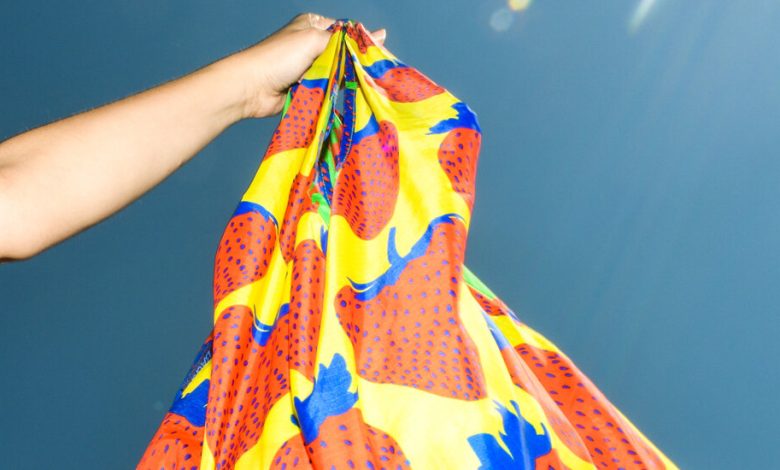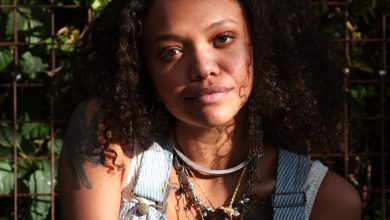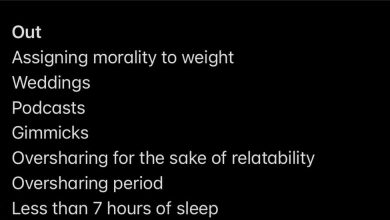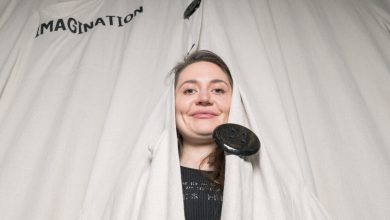Bagging a New Generation

Madi McCool was driving in downtown Philadelphia in the summer of 2020 when she first spotted it: a reusable cloth mask that was actually cute. It was baby blue, orange and white, with a distinctive, bold daisy pattern. It caught her eye immediately.
After some internet sleuthing, she tracked the mask down: It was by Baggu, a brand known primarily for its reusable bags (as the name would suggest). Ms. McCool, 25, got a set of three. Shortly thereafter, she bought her first Baggu bag. Then another. And another. By her estimate, she now owns around 100.
The collection is “giving me so much serotonin,” said Ms. McCool, a grants and communications manager.
Today Baggu is enjoying something of a boom, especially among Gen Z and courtesy of TikTok, which is teeming with self-described “Baggu girlies,” bound together by their appreciation for the brand. Search “Baggu,” and the hundreds of TikToks posted have collected over 130 million views.
Its ubiquity is not only online: Walk around a farmers’ market in any major city and you might lose count of how many Baggu bags you see. On nice days in public parks, Baggu’s prints proliferate on blankets, coolers, towels and even tents, instantly recognizable even without a flashy logo.




Baggus in the wild. Clockwise from top left: in Central Park; also in Central Park; at the Grand Army Plaza Greenmarket; near Seventh Avenue, in Brooklyn.Credit…Dolly Faibyshev for The New York Times
“Baggu started with one product and three people: me, my mom and my childhood best friend,” Emily Sugihara, 40, Baggu’s founder and chief executive, wrote in an email. “After 15 years of slow and steady growth, we are a much bigger team now, but still smaller than you might imagine.”
Ms. Sugihara, who lives in Santa Cruz, Calif., said she was “always an entrepreneurial kid.” While studying economics at the University of Michigan, she and a roommate ran “a successful tiny institution” selling screen-printed T-shirts over the internet.
She went on to study fashion design at Parsons School of Design, then briefly worked as an assistant designer at J. Crew before going freelance. Together with her mother, Joan Hall Sugihara, and her friend Ellen Vanderlaan, the trio released the signature Baggu bag in 2007 after noticing a market need for quality reusable bags that were affordable and attractive. Their timing, she said, was lucky.
“There’s been many waves of people being conscious about environmentalism,” she said, adding that 2007 “was another moment of a new generation of people kind of waking up to the fact that we’re, as a society, making some ridiculous choices.”
Initially, Ms. Sugihara said, the team looked into manufacturing the bags locally in the San Diego area, where she grew up, but the quotes she received priced one bag at $40, “which made it inaccessible for most people.” To keep the low price point they wanted, local factories advised her that the bags would have to be produced in China, so, she said, Baggu worked with a manufacturing agent with a code of conduct and auditors to ensure their products were being made ethically. Baggu then eventually shifted production to a “family-owned factory group” in China that it has worked with for more than 10 years.
The year they launched, the fledgling brand had a course-altering stroke of good luck when it got a one-page spread in the August 2007 issue of Teen Vogue and an influx of orders. The company’s first customers were teenage girls, who connected to the brand’s accessible price point ($8 at the time), the ability to choose the colors that spoke to them and, perhaps most important, its eco-conscious ethos.
The teen girls who formed the backbone of Baggu’s first customer base may be all grown up, but Gen Z has taken their place. Now, instead of a splashy Teen Vogue spread, there’s TikTok, where enthusiasts’ posts serve as user-generated marketing for the brand. It’s there that many are discovering Baggu for the first time.

Soaking up some sun on a Baggu towel in Central Park.Credit…Dolly Faibyshev for The New York Times
TikTok videos of the “what’s in my Baggu” variety are wildly popular, fetching up to 2.7 million views, as fans pull out keys, wallets, hand sanitizer and even six Jimmy John’s subs. And often, there will be more Baggu accessories inside: sunglasses cases, tablet sleeves, organizational pouches and even more reusable bags, neatly folded and ready to be deployed.
As a company, Baggu doesn’t pay or partner with creators to provide affiliate links or partnerships, a practice that’s common on TikTok and Instagram. It will, however, occasionally send free products to the Baggu faithful who are already sharing their dedication to the brand online. Ms. McCool said she had received “maybe three” boxes of free Baggu products since she started posting TikToks featuring the brand. When the brand asked to use one of her videos in an ad, she received a Baggu of her choosing.
In some ways what these influencers are promoting is not just the products themselves, cute as they find them, but a lifestyle of reusable utopia that’s easy in use, exuberant in look.
“I am a baggu girly bc of you,” reads one comment on another “what’s in my Baggu” video posted by Abby Benson-Schwallie, a 24-year-old influencer in Nashville. “I literally bought a baggu wallet after seeing you have one in one of your vids,” reads another. One product, the medium nylon crescent bag, has reached cultlike status on the platform and is often sold out.
There is the matter of price, too: Today, Baggu’s standard reusable bag costs $14, a major factor in its popularity — and accessibility — among a young generation of shoppers for whom cost is a major consideration when making purchases.
Baggu was quickly picked up by retailers including the MoMA Design Store. Ms. Sugihara attributed the brand’s staying power to a deliberate decision to keep its growth slow and steady. “When we’re experiencing a boom time, we’re not hiring as fast as we could,” she said, “and that means when you go into leaner times again, you can get through with your existing team.”
This played out in 2020, at the start of the pandemic, when all the stores the company sold to were closed and Baggu experienced a big drop in web sales. The brand paused all its marketing and set a goal early on to keep its team intact. To do so, they slashed expenses. “We figured out what’s the minimum amount we need to make each month to not fire anybody,” Ms. Sugihara said. Uncertainty was rampant, but the team pivoted production to masks and eventually started marketing again with a successful Earth Day promotion. Nobody was laid off that year, Ms. Sugihara said, and the company stopped producing masks at the end of 2021.
Ms. Sugihara said the company had sold millions of the original bags since the brand debuted but declined to be more specific. The current Baggu team has grown from three to around 90, a number that Ms. Sugihara says is “ever shifting” and includes the staff at the three brick-and-mortar locations the brand operates in New York and San Francisco.
Kate Lindello, founder of the popular fashion resale site Noihsaf Bazaar, said her own Baggu journey evolved in parallel to her life: She was already in love with the standard Baggu before 2012, the year her daughter was born. After that, Ms. Lindello, who lives in Duluth, Minn., added the canvas Baggu backpack to her collection, using it to carry diapers, bottles and snacks. Last summer, while on a family trip, she and her 11-year-old daughter both wore Baggu hats in different styles.
“If a brand can cater to both a 39-year-old mom and her tween daughter,” she said, “that’s pretty impressive.”
Last summer, Angeles Macuil, 23, an assistant manager at a Free People store in the Bay Area, started a Baggu appreciation Facebook group to connect with other Baggu enthusiasts and build a community. In less than a year, membership in the group has grown to more than 2,400. Members buy, sell and trade Baggus or post their “Baggu of the day.” When the crescent bag went viral on TikTok, “I had to enlist moderators because it was too much for me to handle on my own,” Ms. Macuil said.
Displays of Baggu loyalty are occasionally met with resistance. When Ms. McCool posted a “Baggu of the day” video to TikTok, making a selection out of a bin full of dozens of folded Baggu bags, some were quick to criticize. “Is this really more environmentally friendly?” one commenter asked. Another speculated that owning so many reusable bags defeated their purpose.
“I know that I have more bags than any person should have in their entire life,” she said. “But I also know that I haven’t used a single-use plastic bag in like, three years.”





